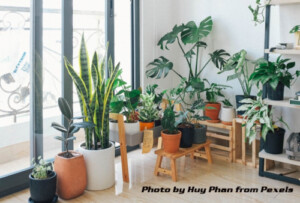Indoor Plants: Enhancing Indoor Air Quality and Promoting Mental Well-being
By Editorial Team

Indoor plants not only add beauty and a touch of nature to our indoor spaces but can also provide several benefits for cleaner indoor air and potentially improve mental health. Here is a detailed explanation of how indoor plants contribute to cleaner indoor air and their potential effects on one’s mental well-being:
- Air purification: Plants play a vital role in purifying indoor air by removing harmful pollutants. Through a process called photosynthesis, plants absorb carbon dioxide and release oxygen. Additionally, plants can absorb volatile organic compounds (VOCs) commonly found in indoor environments, such as formaldehyde, benzene, and xylene, which can be emitted by building materials, furniture, and cleaning products. Some plants, such as the Peace Lily (Spathiphyllum), Spider Plant (Chlorophytum comosum), and Snake Plant (Sansevieria), are particularly effective at filtering these toxins from the air.
- Humidity regulation: Indoor air can become dry, especially during the winter months when heating systems are in use. Plants release moisture vapor through a process called transpiration, which increases the humidity in the surrounding air. This can help alleviate dry skin, respiratory discomfort, and reduce the risk of respiratory infections. Plants like Boston Fern (Nephrolepis exaltata) and Areca Palm (Dypsis lutescens) are known for their humidifying properties.
- Mental health benefits: Research suggests that having indoor plants can have positive effects on mental health and well-being. Here are a few potential benefits:a. Stress reduction: Studies have found that being around plants and engaging in activities such as gardening or simply tending to indoor plants can help reduce stress levels. The presence of plants has been associated with lower blood pressure, heart rate, and perceived stress.
b. Mood improvement: Indoor plants can contribute to a more pleasant and calming environment. The presence of greenery has been linked to improved mood, increased positivity, and a sense of tranquility. The aesthetic appeal of plants can also enhance the visual appeal of indoor spaces, making them more inviting and soothing.
c. Enhanced productivity and concentration: Some research suggests that having plants in work or study environments can improve focus, productivity, and cognitive performance. The presence of plants may reduce mental fatigue and increase attention span, leading to better concentration and efficiency.
d. Psychological well-being: Indoor plants can create a connection with nature, even in urban settings, which has been shown to have a positive impact on psychological well-being. They can provide a sense of nurturing, responsibility, and companionship, fostering a sense of purpose and satisfaction.
It’s important to note that while indoor plants can contribute to cleaner indoor air and potentially improve mental health, they should not replace professional medical or mental health treatment. If you are experiencing significant mental health concerns, it’s essential to seek guidance from a qualified healthcare professional.
When incorporating indoor plants into your living or working space, consider factors such as lighting conditions, proper watering and maintenance, and selecting plants suitable for indoor environments. Nothing herein is intended to diagnose, treat or cure any disease.
Link: FindTreatment.gov is an online source of information for persons seeking substance use and/or mental health treatment facilities in the United States or U.S. Territories.

